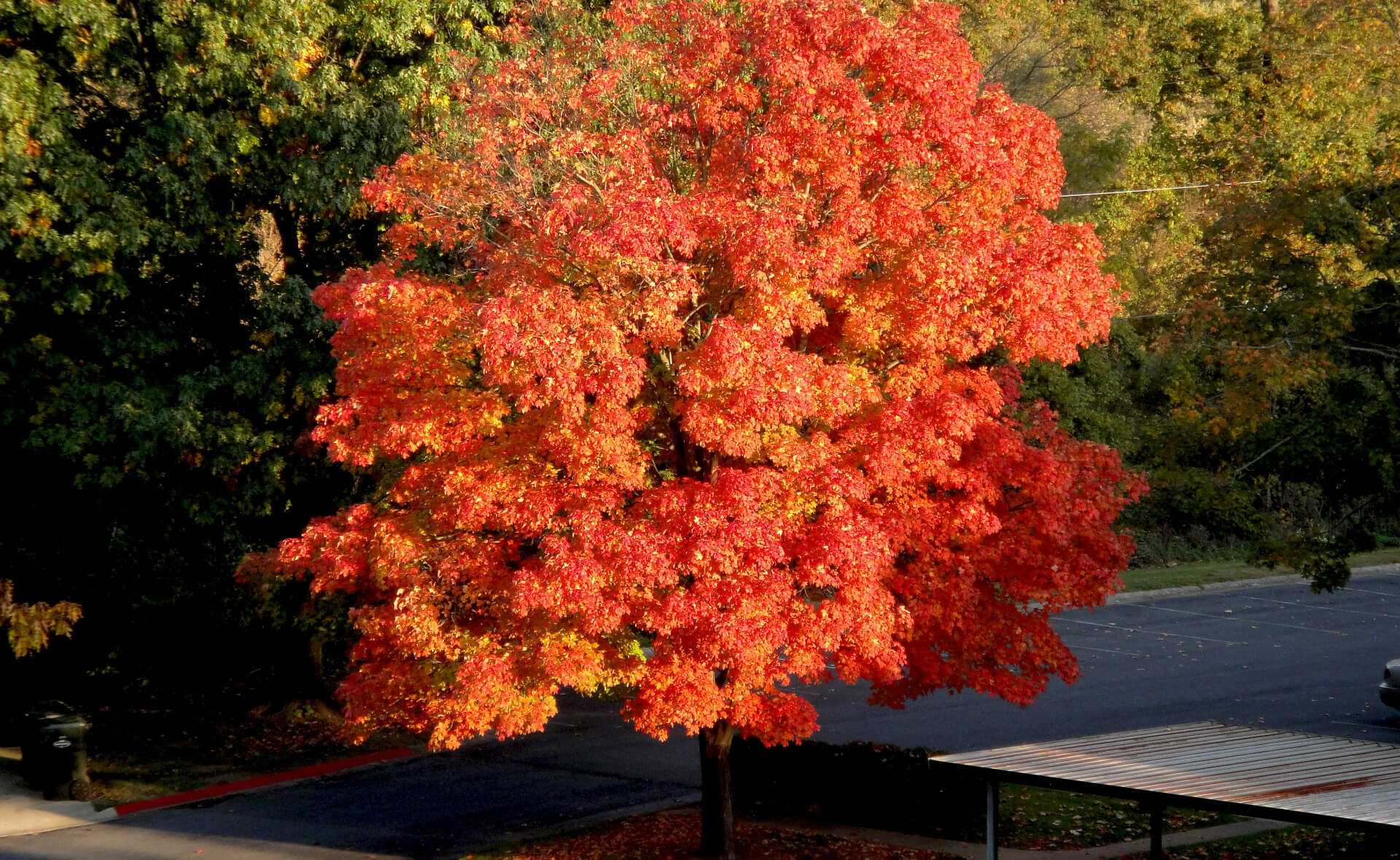The Enchantment of Sugar Maple Trees

Share
Delights for Generations
In garden enchantment, few trees match the sugar maple's captivating beauty and timeless allure (Acer saccharum). Known for its vibrant foliage, sweet sap, and majestic presence, the sugar maple tree has long been a favorite of gardeners and nature enthusiasts. As we embark on a journey to explore the wonder of sugar maples, we will uncover their rich history, role in the garden, and the many delights they offer those fortunate enough to cultivate them.
A Sugar Maple's Story
The sugar maple, native to the northeastern United States and southeastern Canada, boasts a fascinating history that spans centuries. It holds a special place in the hearts of North Americans for its dual importance as both a stunning ornamental tree and a valuable source of maple syrup.
One must mention the time-honored tradition of maple sugaring to discuss sugar maples. As the weather transitions from winter's icy grasp to the gentle warmth of early spring, sugar maples come to life each spring. Their sap flows freely, heralding the arrival of the sweetest season of the year. For generations, people have tapped sugar maple trees to harvest this sap and transform it into the liquid gold known as maple syrup. This time-honored practice has become a part of North American culture, with maple syrup festivals and traditions celebrated in many regions.
The sugar maple's leaves, adorned with their signature five-lobed shape and vibrant autumnal colors, are another reason this tree is highly esteemed. Sugar maples paint the landscape in the fall with a breathtaking array of reds, oranges, and yellows. These stunning shades create a mesmerizing spectacle that captures the imagination and evokes a sense of awe.
The Garden's Elegance
Sugar maples are an integral part of history and a vital element of the modern garden. These magnificent trees bring elegance and grace to any landscape. Whether planted as a single specimen or in a grove, sugar maples make a profound statement with their towering stature and picturesque foliage.
- Shade and Comfort: One of the most sought-after attributes of sugar maples is their ability to provide ample shade. Their broad, spreading canopies offer respite from the scorching sun during the summer months, creating a comfortable oasis for outdoor gatherings, picnics, or simply enjoying a book in the garden.
- Four-Season Beauty: Sugar maples are a true treasure for gardeners who appreciate the beauty of all seasons. In the spring, delicate red and yellow flowers adorn the branches, attracting pollinators and adding charm to the landscape. During the summer, their lush green leaves offer a refreshing contrast to the season's warmth. Come fall, their leaves transform into a kaleidoscope of colors, creating a mesmerizing scene. Even in winter, the silver-grey bark of mature sugar maples stands out against the snow-covered landscape, adding elegance to the garden.
- Wildlife Haven: Sugar maples provide habitat and food for wildlife, and their striking appearance adds to their appeal. Birds, squirrels, and other creatures find shelter in the branches and feast on the seeds produced by these trees. The sweet sap of sugar maples also supports a host of insect species, further enriching the garden's biodiversity.
- Nurturing the Soul: Beyond their practical benefits, sugar maples uniquely encourage the human spirit. Sitting beneath the canopy of a mature sugar maple can be a deeply meditative and soul-soothing experience. The rustle of leaves in the breeze, the dappled sunlight filtering through the branches, and the sense of timelessness evoked by these venerable trees create a profound sense of tranquility.
Sugar Maple Varieties
While the classic sugar maple (Acer saccharum) remains a garden favorite, several noteworthy cultivars offer unique characteristics and can be tailored to specific preferences. Here are a few notable sugar maple varieties:
- 'Autumn Blaze' (Acer x freemanii 'Autumn Blaze'): This cultivar is celebrated for its rapid growth and brilliant fall foliage. Its leaves turn an intense scarlet in the autumn, making it a standout choice for those seeking a vibrant display.
- 'Legacy' (Acer saccharum 'Legacy'): Known for its exceptional disease resistance and vibrant orange-red autumn leaves, 'Legacy' is a fantastic choice for gardeners who desire a low-maintenance yet visually stunning sugar maple.
- 'Green Mountain' (Acer saccharum 'Green Mountain'): With its deep green summer foliage and brilliant orange-red fall colors, 'Green Mountain' is a versatile choice that adds beauty to any garden.
- 'Caddo' (Acer saccharum 'Caddo'): This dwarf sugar maple variety is ideal for smaller gardens or ornamental accents. Its compact size and striking fall foliage make it an attractive choice for urban landscapes.
Cultivating Sugar Maples
Cultivating sugar maples in your garden requires careful consideration and proper care to ensure their health and longevity. Here are some essential tips for successful sugar maple cultivation:
- Site Selection: Sugar maples thrive in well-drained soil with slightly acidic to neutral pH levels. Select a location that receives abundant sunlight to ensure the best growth and coloration of leaves. Adequate spacing between trees is essential to allow for proper air circulation and reduce resource competition.
- Planting: When planting sugar maples, ensure the planting hole is at least twice the width of the root ball to provide ample room for root expansion. Water deeply after planting to help establish the tree.
- Watering: Sugar maples benefit from regular watering, especially during dry spells. Maintain consistent soil moisture to prevent stress and maintain the tree's health.
- Mulching: For better moisture retention, temperature regulation, and weed discouragement, spread a layer of organic mulch around the tree's base. Keep the mulch away from the trunk to prevent rot.
- Pruning: Prune sugar maples during their dormant season to shape the tree, remove dead or diseased branches, and improve overall structure. It is advisable to avoid excessive pruning of trees during the growing season. This is because heavy pruning can cause stress to the tree and affect its growth.
- Fertilization: Regularly assess your soil's nutrient levels and provide appropriate fertilizer. Sugar maples typically benefit from a balanced slow-release fertilizer.
- Pest and Disease Management: Watch for common pests and diseases that affect sugar maples, such as aphids, scale insects, and tar spot fungus. It is of utmost importance to detect any issues with trees as early as possible and provide appropriate treatment to ensure their continued good health.
The sugar maple tree, with its rich history, breathtaking beauty, and multifaceted role in the garden, is a true treasure for gardeners and nature enthusiasts alike. Its ability to provide shade, four-season beauty, and a sense of tranquility makes it an invaluable addition to any landscape.
As you embark on your journey to discover the enchantment of sugar maples, remember to care for and nurture these majestic trees to ensure they continue to grace your garden with their timeless allure for generations to come. Whether you seek the sweet pleasures of maple sugaring or yearn for a touch of natural elegance in your garden, the sugar maple tree is ready to delight and inspire you.
